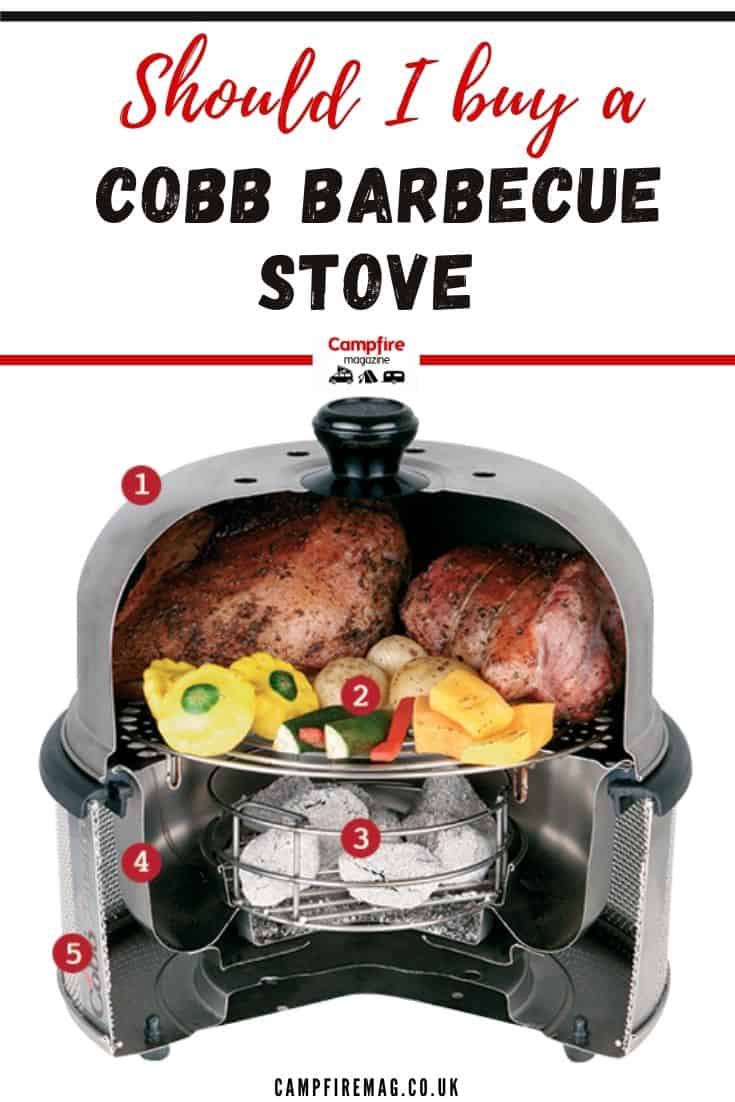Did you know?
The Cobb was initially designed as an electricity-free cooking system for people in rural areas in Africa. The original fuel source for the Cobb was dry corn-cobs, abundant in rural Africa – hence the name.
Cobb barbecue ovens for camping
The Cobb has been cleverly developed into its present incarnation, which is fairly light (about 4kg) and portable.
Instead of corn-cobs, it works on charcoal briquettes, lumpwood charcoal or its own ‘cobblestone’.
As well as the standard Cobb (now up-dated as the Premier Air), there’s also a compact version, but it’s way too small even for two people. For a larger family, there’s also the Supreme (oval and large enough to take two whole chickens).
Prices range from around £90 to more than £200.
Cobb bits and pieces can be hard to come by as they go out of stock quite often. We do update our links regularly.
How does the Cobb work?

As you can see from the cutaway picture, the Cobb is made up of an outer ‘shell’, which stays cool when cooking. Inside, a stainless steel bowl holds a metal basket, which you fill with your fuel. Firelighters sit in the bowl under the basket.
Once your fuel is going, you place the grill and lid on the oven to heat up. The grill is a slightly convex non-stick plate with holes. Oils run down to the sides, through the holes and into the outer section of the steel bowl. That means you don’t get oil on the charcoal, so no flame or smoke and healthier food.
1. Dome: made with stainless steel and it has a heat-resistant handle. The holes in the Dome ensure even ventilation throughout the cooking process creating an oven effect.
2. Grill Grid: with an easy to clean Teflon® non-stick coating. Excess fat drains away through the holes and into the moat.
3. Fire Grid: A secured area for the Cobble Stone or loose briquettes.
4. Stainless steel moat: catches all excess fat. The moat can also be used for cooking vegetables.
5. Base: with anti-slip rubber feet, the base remains stable and cool to touch during use.
Accessories galore
There’s a range of accessories for different types of cooking, including a saute pan for frying and a nice paella, a griddle and a pizza stone. You can bake, smoke, make stews or just use it as a barbecue (though we’ve found the Lotus Grill does a better job of that).
You can, of course, use your own pans, griddles, pizza stone (the Unicook pizza stone is only a centimetre different to the Cobb’s, for example, and a lot cheaper). The diameter of the Cobb top is 33cm. Obviously these make some great camping gifts should someone needs an idea.
Putting the Cobb to the test
We put the Cobb oven through its paces with a delicious menu.
We made star anise and chilli marinated trout with an orange and watercress salad and orange chilli sauce, followed by skewers of garlic and ginger marinated paneer for the vegetarians and turkey for the meat-eaters (both with red peppers, courgette and onion).

We served the kebabs with bulgur wheat salad and tzatziki. The fish was the star of the meal, and you can find our recipe here.

We used environmentally friendly firelighters (no kerosene) and seven ‘heat bead’ briquettes. It took around 25 minutes for the briquettes to get to the right temperature. We then warmed up the grill plate for five minutes.
The Cobb almost won us over, but…
- We loved being able to cook with the Cobb on the table. It’s a much more sociable and comfortable way of cooking.
- Strangely, we didn’t appreciate one of its best features till after we’d eaten – no smoke! One of our guests suddenly realised they’d been sitting right next to the oven without streaming eyes and smelly clothes.
- The grill (which is the basic attachment and comes with all Cobb models) is fantastic for fish and smaller pieces of food. There was none of the usual food sticking to the barbecue grille and then falling through into the fire.
- It was very easy to clean and stow away in its bag.
- It came with a simple, but handy, lifting tool for moving the grill plate and charcoal basket.
However, if you’re looking for a tabletop, smokeless barbecue with efficiency and good looks, the LotusGrill wins hands down. You can see our review here.
If you’re looking for a versatile camping stove, then the Cadac is best.
Some things to consider
- The lid is vital. At first, we treated the Cobb as a basic barbecue and left it lid-less. It took far too long for our food to cook.
- There’s some learning to do in getting the amount of fuel right. We used just seven briquettes, but found nine would have been better for our menu. It all depends on the amount of food and the length of time you want to cook for.
- The edges of the grill plate don’t get as hot as the centre. If you’re making kebabs on skewers, go for shorter lengths to make sure you’re not left with raw ends and cooked middles!
- The newest Premier Air Cobb costs around £140. A full set of accessories can work out expensive. Take a bit of time to work out what sort of cooking you want to do or will, realistically do, and decide on your accessories accordingly. You can always buy more later.
- The Cobb is less fierce than a barbecue, so cooking takes a little longer
If you’ve used the Cobb and have a tip or a recipe to share, do leave a comment below.
Do you prefer the Lotus Grill too? Let us know what you think about that and our other favourite, the gas-powered Cadac Safari Chef.





